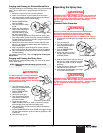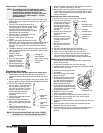
English
Extension Cord Selection
If an extension cord is used, make sure that it is of the 3-
conductor type with NEMA connectors so a continuous
grounding circuit is provided from the tool to the power circuit
receptacle. Also, be sure that the conductor size is large
enough to prevent excessive voltage drop which will cause
loss of power and possible motor damage to the unit. A table
of recommended extension cord sizes is shown below.
For nameplate ampere ratings which are between those given,
use the extension cord recommended for the next higher
ampere rating.
If an extension cord is to be used outdoors, it must be marked
with the suffix W-A following the cord type designation. For
example, SJTW-A to indicate that it is acceptable for outdoor
use.
Use only a 3-wire extension cord that has a 3-blade grounding
plug and a 3-slot receptacle that will accept the plug on the
product. Make sure your extension cord is in good condition.
When using an extension cord, be sure to use one heavy
enough to carry the current your product will draw. An
undersized cord will cause a drop in line voltage resulting in
loss of power and overheating. A 14 or 12 gauge cord is
recommended.
NOTE: Do not use more than 100 feet of extension
cord. If you need to paint further than 100 feet
from your power source, use more paint hose,
not more extension cord. Shorter extension
cords will ensure maximum electrical power for
proper operation.
Extension Cord Length
Nameplate Ampere Rating
25 ft.
0 to 5 18 18 18 18 18 18
18 18 18 18 18 16
18 18 18 18 16 16
18 18 18 16 16 16
18 18 18 16 16 14
18 18 18 16 14 14
16 16 16 16 14 14
16 16 16 16 14 14
16 16 16 14 14 14
14 14 14 14 14 12
14 14 14 14 14 12
14 14 14 14 12 12
14 14 14 14 12 12
14 14 14 14 12 12
12 12 12 12 12 12
12 12 12 12 12 12
6
7
8
9
10
11
12
13
14
15
16
17
18
19
20
50 ft. 75 ft. 100 ft.125 ft.150 ft.
4 © SprayTECH Corporation. All rights reserved.
Operation
Purging and Priming
Always keep the spray gun locked in the off position while
purging the system.
If this unit is new, it is shipped with test fluid in the fluid section
to prevent corrosion during shipment and storage. If you are
going to spray with latex paint, this fluid must be thoroughly
cleaned out of the system. For spraying with solvent-based
paint, thorough cleaning of this material is not necessary.
If it is already in service, you will need to purge the water or
solvent used in cleanup.
Purging and Priming the Pump for Latex Paint
1. Secure the return hose into a waste container.
2. Place a bucket of soapy water under the suction tube.
3. Turn the pressure control
knob fully counterclockwise
to reduce the pressure to
its lowest setting.
4. Set the PRIME/SPRAY
valve to PRIME.
5. Turn the ON/OFF switch to
ON.
6. Slowly turn the pressure
control knob clockwise to
increase the pressure until fluid starts to come out of the
return hose. Use only enough pressure to keep the fluid
coming out.
7. Turn the pressure control knob fully counterclockwise to
its lowest setting when the test fluid is purged and soapy
water is coming out of the return hose.
8. Remove the bucket of soapy water from the suction tube
and replace it with a bucket of clear water.
9. Increase the pressure to the minimum necessary to keep
fluid flowing until clear water is coming out of the return hose.
10. Turn the pressure control knob fully counterclockwise to
its lowest setting.
11. Remove the bucket of water
from under the suction tube
and replace it with a
container of latex paint.
12. Increase the pressure slowly
until paint is coming through
the return hose.
13. Remove the return hose
from the waste container and
place it in its operating
position above the container of latex paint.
14. Keep circulating the paint through the system until the
paint coming out of the return hose is free of air bubbles.
15. Turn the pressure control knob fully counterclockwise to
its lowest setting.
The pump is now purged. Skip to Purging and Priming the
Spray Hose.
S
P
R
A
Y
P
R
I
M
E
SP
R
A
Y
PRI
ME
Pressure Control Knob
CAUTION


















